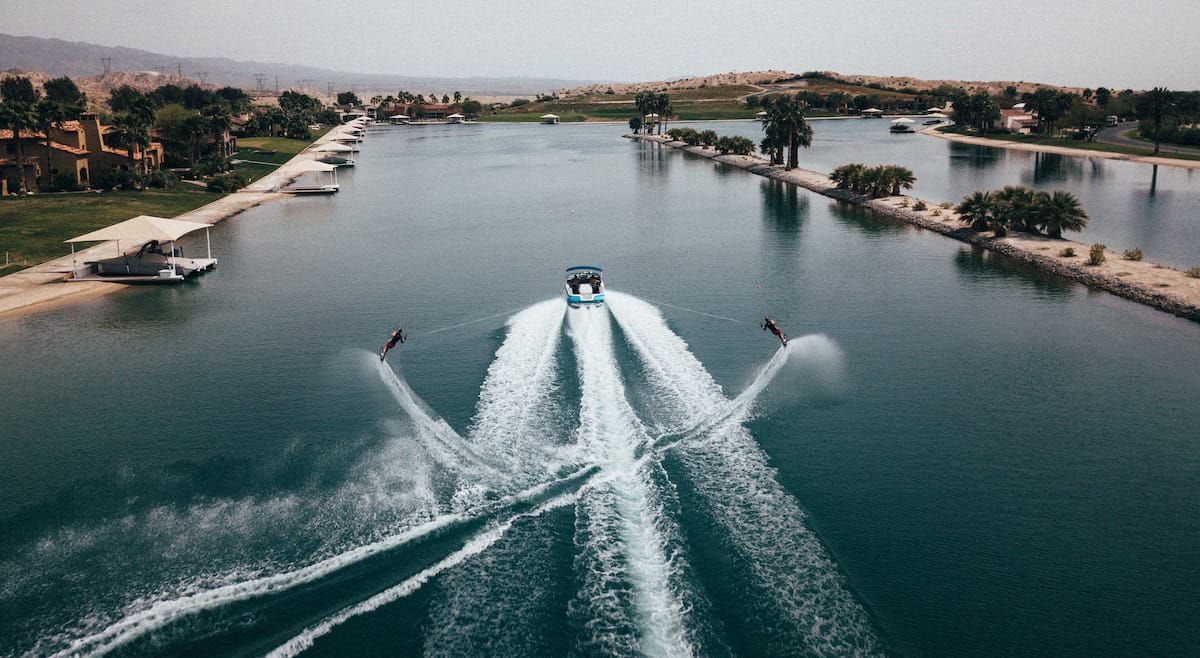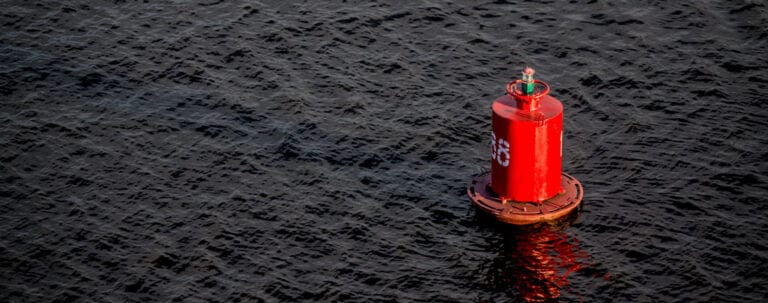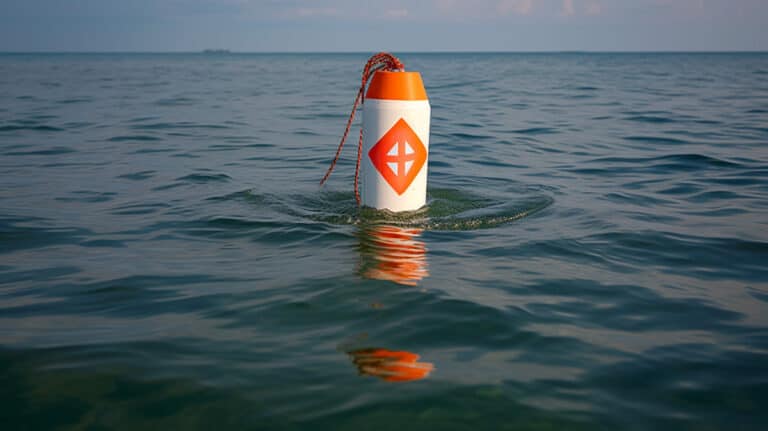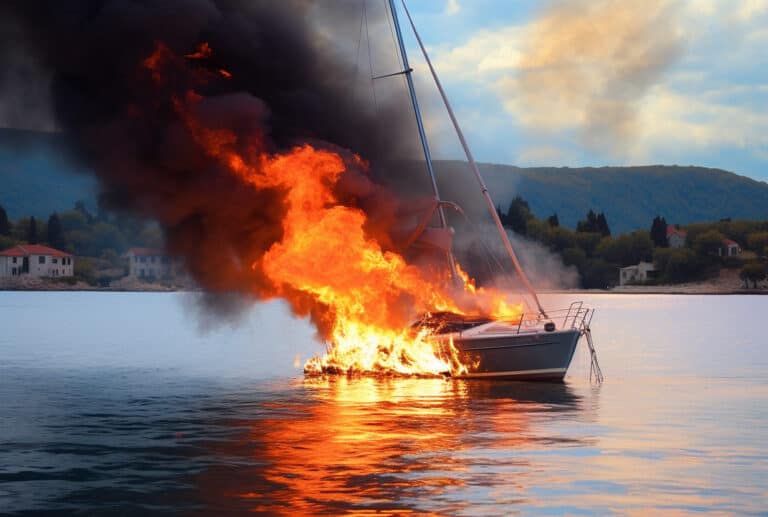There’s nothing quite like the thrill of water skiing, especially when you’re sharing the experience with friends or family.
However, when “a boat is towing two skiers at the same time, how long should the tow lines be?” is a crucial question to ensure everyone’s safety and enjoyment.
This guide will cover everything you need to know about tow line length, safety precautions, and best practices for a fun and unforgettable day on the water.
Short Summary
Ideal tow line length for two skiers is 75 ft, but adjust depending on terrain, wind speed & weight of skiers.
Choose a boat that can handle the additional weight and maintain control when towing multiple skiers. Use hand signals to communicate effectively with them.
Follow best practices such as starting/stopping slowly, monitoring performance & being prepared for emergencies while water skiing!
Determining the Ideal Tow Line Length for Two Skiers
Tow line length plays a significant role in the overall experience and safety of water skiing with two skiers. The ideal tow line length for two skiers is around 75 feet, but this can vary depending on factors such as terrain, wind speed, and the weight of the skiers.
It’s essential that both tow lines are the exact same length to ensure that both skiers stay in sync with the boat and eliminate the risk of one skier getting left behind or pulled ahead.
Factors Affecting Tow Line Length
Several factors can impact the ideal tow line length for two skiers. These include the terrain, wind speed, and the weight of the skiers. By considering these factors, boat operators can adjust the tow line length to provide a safe and enjoyable skiing experience for both skiers.
It’s also crucial for boat operators to maintain a safe distance from other boats, docks, buoys, swimmers, and other hazards while towing two skiers. This can help prevent accidents and ensure a smooth water skiing experience for everyone involved.
Safety Precautions for Towing Multiple Skiers
Safety should always be the top priority when towing multiple skiers. To ensure everyone’s safety and enjoyment, it’s essential to address three main safety precautions: boat capacity and handling, speed limits and control, and proper communication and hand signals. By following these safety precautions, boat operators and skiers can enjoy a thrilling day on the water with minimal risks.
Boat operators should also be aware of the potential dangers that could arise if skiers have different length tow lines when being towed together. This can lead to dangerous situations where one skier might run into another skier’s tow line. To prevent such incidents, always use tow lines of the same length.
Boat Capacity and Handling
Before towing multiple skiers, it’s essential to ensure that the boat has the capacity to handle the additional weight. The boat must be able to fit at least three people: the driver, the observer, and the skier being picked up. When checking a boat’s capacity and handling, consider the size and power of the boat, as well as how many people it can hold.
It’s crucial to choose a boat that can safely tow multiple skiers without compromising its performance or stability. This will help ensure a smooth and enjoyable skiing experience for both the skiers and the boat operator.
Speed Limits and Control
When towing two water skiers, especially if they’re just starting out, it’s best to stick to speeds of 25-35 mph. However, speed limits may vary depending on the location and specific conditions. Boat operators should maintain a steady speed and adjust as necessary based on the skiers’ experience and comfort levels.
It’s also essential to maintain control of the boat while towing multiple skiers. This includes keeping a consistent speed, keeping the tow lines tight, and ensuring both skiers are in line with the boat. By following these guidelines, boat operators can provide a safe and enjoyable experience for all skiers.
Communication and Hand Signals
Proper communication between skiers and boat operators is crucial for a safe and enjoyable water skiing experience. Hand signals are an effective way to communicate important information, such as speed adjustments and direction changes. For example, when towing multiple skiers, the hand signal to slow down is holding the thumb down.
Skiers should also let the boat operator know when they’re ready to start and stop skiing, and the boat operator should communicate the speed and direction of the boat to the skiers. By ensuring clear and effective communication, skiers and boat operators can work together to create a fun and safe water skiing experience.
Material and Quality of Ski Tow Lines
The material and quality of ski tow lines play a significant role in the overall safety and performance of water skiing. Tow lines should be made of strong, flexible, and durable materials like polyethylene or polypropylene that won’t kink.
These materials are specifically designed to absorb the shock when going through waves, making sharp turns, or cutting across boats, providing a smoother water skiing experience.
It’s important to choose a tow line with a breaking strength of over 800 pounds to ensure it can handle the weight and force exerted by multiple skiers. By investing in a high-quality tow line, skiers and boat operators can enjoy a safer and more enjoyable day on the water.
Polyethylene and Polypropylene
Polyethylene and polypropylene are the two most common materials used for ski tow lines. Polyethylene is lightweight and flexible, making it a popular choice for water skiing. It is also resistant to abrasion, UV radiation, and chemicals, and has a low coefficient of friction. However, it is not as strong as polypropylene and can stretch and break more easily.
Polypropylene is stronger and more rigid than polyethylene, making it better suited for heavier loads. It is also resistant to abrasion, UV radiation, and chemicals, and has a higher coefficient of friction.
When choosing the best material for ski tow lines, consider factors such as strength, flexibility, and durability to ensure optimal performance and safety.
Choosing the Right Ski Tow Line
Selecting the ideal ski tow line involves considering factors such as material, length, and breaking strength. As mentioned previously, polyethylene and polypropylene are popular materials for ski tow lines due to their strength, flexibility, and durability.
When considering length, the recommended tow line length for two skiers is around 75 feet, but this can vary depending on factors such as terrain, wind speed, and the weight of the skiers.
To ensure the safety and enjoyment of all skiers, it’s essential to properly maintain ski tow lines. This includes checking them regularly for signs of wear and tear and using the right size and length of line for the load being towed. By selecting and maintaining the right ski tow line, skiers and boat operators can enjoy a thrilling and safe water skiing experience.

Best Practices for Towing Two Skiers
To ensure a fun and safe water skiing experience, it’s essential to follow best practices when towing two skiers. These practices include starting and stopping the boat slowly, maintaining balance and control, and monitoring skier performance. By following these guidelines, boat operators can provide a smooth and enjoyable experience for both skiers while minimizing the risk of accidents.
Additionally, boat operators should always stay vigilant and aware of potential obstacles while towing multiple skiers. This includes keeping a safe distance from other boats, docks, buoys, swimmers, and other hazards. By staying alert and practicing safe skiing techniques, boat operators and skiers can enjoy a thrilling day on the water with minimal risks.
Starting and Stopping
Gradual starts and stops are crucial when towing two skiers. This allows both skiers to maintain their balance and control without being caught off guard by sudden changes in speed. To start off, the boat operator should begin slowly and head in the right direction before gradually increasing speed to help the skiers clear the waves.
When slowing down, the boat operator should ease the throttle back, allowing the boat to move forward and slacken the tow rope. This ensures a smooth and controlled stop while minimizing the risk of skier falls or accidents.
Maintaining Balance and Control
Maintaining balance and control is critical when towing two skiers. Boat operators should keep a consistent speed, ensure the tow lines are tight, and make sure both skiers are in line with the boat. This helps prevent skiers from losing their balance or control, which could lead to falls or accidents.
In addition to maintaining balance and control, boat operators should also be mindful of the surrounding environment and potential obstacles. This includes staying aware of other boats, docks, buoys, swimmers, and other hazards that could pose a risk to the skiers and the boat.
By staying alert and maintaining control, boat operators can provide a safe and enjoyable water skiing experience for all skiers.
Monitoring Skier Performance
Keeping an eye on skier performance is essential when towing multiple skiers. This allows boat operators to make adjustments as needed, ensuring the safety and enjoyment of all skiers. Monitoring skier performance includes observing their body positions and movements, as well as communicating with the skiers and the boat driver.
In the event of a skier fall or emergency, the observer should inform the boat operator immediately and follow proper safety guidelines. By staying vigilant and monitoring skier performance, boat operators can help prevent accidents and ensure a fun and safe water skiing experience for all participants.
Handling Skier Falls and Emergencies
While water skiing is an exciting activity, it’s not without its risks. Skier falls and emergencies can occur, and it’s crucial to know how to handle these situations properly to ensure the safety of everyone involved. When a skier falls or an emergency arises, approach the situation cautiously and be prepared with a plan to address the issue.
Being aware of the risks associated with water skiing can help prevent accidents and make for a safer experience. Risks include crashing into other boats, skiers, or obstacles in the water, as well as falling and getting injured. By staying alert and practicing safe skiing techniques, boat operators and skiers can minimize these risks and enjoy a thrilling day on the water.
Approaching a Fallen Skier
When approaching a fallen skier, it’s vital to proceed with caution. Boat operators should slow down and circle the skier slowly, keeping the skier in sight and on their side of the boat. The skier should signal to the observer that they are okay by holding both arms up above their head.
Once the boat has come to a stop, the operator can carefully approach the skier to assist them. It’s essential to be mindful of the boat’s propeller and any potential hazards in the water to ensure the safety of both the skier and the boat operator.
Emergency Preparedness
Being prepared for emergencies is crucial when participating in water skiing activities. This includes having emergency contact information readily available, such as the resort’s emergency services, local emergency services, and any other helpful contacts. In the event of an injury or other emergency, call for help immediately and follow the necessary safety procedures.
In addition to having emergency contact information on hand, it’s essential to be prepared to provide first aid if necessary. By being prepared for emergencies and knowing how to respond, boat operators and skiers can help ensure a safer and more enjoyable water skiing experience.
Frequently Asked Questions
How long should towlines be when towing 2 skiers?
When towing two skiers, tow lines should be between 60 and 85 feet long, depending on the skill level of the skiers. Generally, they should be twice as long as the space between the skiers and of equal length for each skier.
What is the maximum length for tow lines when water skiing?
The maximum length for tow lines when water skiing is 75 feet. Although some advanced skiers may opt for longer ropes, the majority of water skiers should stick with a 75-foot long rope for the best results.
This rope length is ideal for most skiers, as it allows for a good balance between speed and control.
When towing a skier how far should the vessel operator keep the skier from the shoreline?
When towing a skier, the vessel operator should keep the skier a minimum of 100 feet away from the shoreline. This will ensure the safety of both the skier and other people in or near the water.
During what hours is it legal to tow a person behind a boat on water skis or other device?
In the U.S., boating and water sports regulations, including the legal hours for towing water skiers, vary by state. However, a common guideline, based on the U.S. Coast Guard’s Federal Navigation Rules, allows such activities from sunrise to sunset. Nighttime water skiing is typically prohibited for safety reasons. In addition, the vessel must have another competent person on board to act as an observer or be equipped with a wide-angle rearview mirror.
What is the maximum number of water skiers that may be towed legally behind a vessel?
there’s no universally applied federal limit to the number of water skiers that may be towed behind a vessel in the United States. The regulation can vary state by state. Some states might limit the number of skiers based on the size and type of the boat, while others may not specify a limit at all. The focus of most regulations is on safety rather than the specific number of skiers. For instance, ensuring there is a designated observer on board in addition to the driver.
Summary
In conclusion, water skiing with friends and family can be a thrilling and unforgettable experience.
However, it’s essential to prioritize safety and proper tow line length when towing multiple skiers. By following the guidelines and best practices outlined in this guide, skiers and boat operators can enjoy a fun and safe day on the water.
So grab your tow lines, hop on your skis, and get ready to create lasting memories with your loved ones on the open water!




